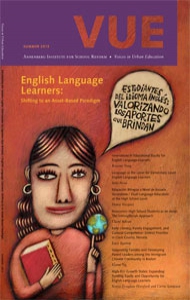Rather than view educating English language learners as a problem, the innovative practitioners, scholars, and policy analysts writing in this issue of VUE urge us to embrace and value ELLs as bicultural, bilingual leaders of the future.
English Language Learners: Shifting to an Asset-Based Paradigm / Estudiantes del Idioma Inglés: Valorizando los Aportes Que Brindan

Rather than viewing educating English language learners as a problem, this issue calls for embracing and valuing ELLs as bicultural, bilingual leaders of the future.
Bilingual education should be seen not as a remedial program for immigrant students, but as an enrichment program to help all students, including native English speakers, to be competitive in a global marketplace.
A dual-language program at one high school aims to send the message: “We value all of who you are – both languages are equally important.”
In a practitioner-led high school model serving new immigrant students, all teachers simultaneously support both language and content, and students are taught in groups of heterogeneous English proficiency levels.
Engaged families and community members, along with culturally competent and data-savvy teachers and principals, are key goals in a district with a burgeoning English language learner population.
A community organization provides integrated services to immigrant families, grounded in their culture and language, to help parents build on their strengths and support the family’s education, health, and social needs.
The growing numbers of English language learners across the country provide an opportunity for state policymakers and education leaders to invest in and reap the benefits of a well-educated, culturally competent workforce.







